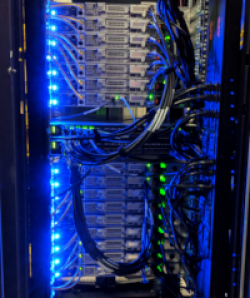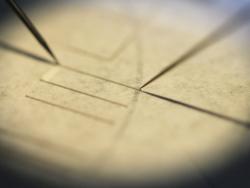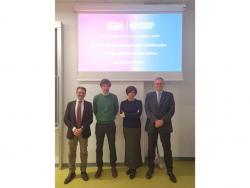- Home
- Department
- Research
- Teaching
- Post Graduate Studies
- Knowledge Transfer
- How To
Department of Excellence
News
HPC cluster "bora"
April 29th, 2024
We recently completed the installation of the new high-performance computing (HPC) cluster "bora", as part of the funding of the "Dipartimento di Eccellenza". It is an hybrid and extensible computing infrastructure, equipped with state-of-the-art architectures. The cluster comprises:
- standard CPU nodes, with general purpose processors;
- fat CPU nodes, with a large amount of RAM;
- GPU nodes, equipped with high-end NVIDIA graphics cards.
It also features two data storage levels, characterized by different storage space and speed. At the moment, the cluster is relatively small overall (216 cores, 2 GPUs A30), but an extension is expected in the second part of the project of the "Dipartimento di Eccellenza".
 The researchers and the students of the Department of Physics will soon be able to use the cluster for all those research and teaching activities requiring HPC resources. Possible applications of the cluster include:
The researchers and the students of the Department of Physics will soon be able to use the cluster for all those research and teaching activities requiring HPC resources. Possible applications of the cluster include:
- development and test of software before running on large-scale infrastructures;
- simulation and data analysis in custom software and hardware environments;
- familiarize students with HPC environments.
Here are some possible applications of the cluster in the research groups involved in HPC:
- Condensed matter physics: atomistic simulation of nano-structured, disordered or complex materials, using a range of computational methods such as classical molecular dynamics, ab-initio simulation, or Quantum Monte Carlo.
- Astrophysics: simulation of galaxy formation and cosmic structures, using both in-house and community software (OpenGADGET, PINOCCHIO), as well as data analysis of large-scale cosmological surveys.
- High-energy and astro-particle physics: simulation and analysis of big-data produced by cosmic ray observatories (Fermi, CTA) and gravitational wave observatories (LIGO-Virgo-Kagra), as well as by high-energy particle experiments at CERN (CMS, Alice).
- Applied physics: development of specialized imaging algorithms for imaging and high-resolution tomography and their application in experimental activities at the Elettra lab.
Research line: HPC-BD-ML
New AJP LAB Interdisciplinary Laboratory
Inaugurated on December 4th, 2023
The newly established interdisciplinary laboratory, known as "AJP LAB", is now fully operational thanks to recent efforts focused on ultra-thin semiconductor detectors by researchers from the Department of Physics. These endeavors mark the inaugural phase of the Interdisciplinary Laboratory of Advanced Electronics and Sensors (LEA), presently in the developmental stages.
At the core of the AJP LAB facility lies the "Aerosol Jet Printer - AJP", an innovative instrument procured by the University of Trieste towards the end of 2023 through an exceptional funding initiative for large-scale instrumentation. This acquisition was made possible through the collaborative proposal put forth by researchers from the Departments of Physics (DF), Engineering and Architecture (DIA), and Chemical and Pharmaceutical Sciences (DSCF).
 Equipped with cutting-edge technology, the AJP enables the printing of tracks or the fabrication of three-dimensional structures on diverse substrates utilizing a variety of "inks," including metals, polymers, and chemical and biological compounds. This process involves nebulizing the material and depositing it layer by layer via a jet guided by high-speed gas. As a result, complex prototypes can be realized in significantly reduced timeframes compared to conventional methodologies, thereby revolutionizing the research and development landscape.
Equipped with cutting-edge technology, the AJP enables the printing of tracks or the fabrication of three-dimensional structures on diverse substrates utilizing a variety of "inks," including metals, polymers, and chemical and biological compounds. This process involves nebulizing the material and depositing it layer by layer via a jet guided by high-speed gas. As a result, complex prototypes can be realized in significantly reduced timeframes compared to conventional methodologies, thereby revolutionizing the research and development landscape.
The versatility of the Aerosol Jet Printer extends across a wide spectrum of multidisciplinary applications in different fields such as chemistry, physics, and engineering. These applications range from the development of detectors for nuclear and particle physics to medical physics, and from chemistry and crystallography to aerospace engineering and satellite communications.
Initially, professors and researchers from the Department of Physics have outlined plans to leverage the capabilities of the AJP printer for various endeavors, including the development of semiconductor pixel detectors for particle physics research, phase-contrast-based medical X-ray imaging, and aerospace robotics applications integrating mechanics, circuits, and sensors.
 In the initial printing campaigns conducted during the early months of 2024, the use of a silver ink air solution allowed for the deposition of conductive traces on glass and silicon substrates, followed by the measurement of their electrical and mechanical properties. The preliminary findings, disseminated within the working groups of the researchers’ experiment collaborations, have generated considerable interest due to the potential simplification it offers in integrating particle detectors, particularly concerning power distribution on large-area chips and contactless interconnection of ultra-thin sensors. Furthermore, this research has attracted additional funding from external sources, enabling a further exploration and refinement of this groundbreaking technique.
In the initial printing campaigns conducted during the early months of 2024, the use of a silver ink air solution allowed for the deposition of conductive traces on glass and silicon substrates, followed by the measurement of their electrical and mechanical properties. The preliminary findings, disseminated within the working groups of the researchers’ experiment collaborations, have generated considerable interest due to the potential simplification it offers in integrating particle detectors, particularly concerning power distribution on large-area chips and contactless interconnection of ultra-thin sensors. Furthermore, this research has attracted additional funding from external sources, enabling a further exploration and refinement of this groundbreaking technique.
Research line: LEA
Last update: 05-06-2024 - 11:41








